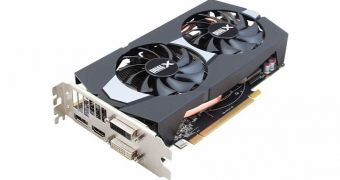Advanced Micro Devices was supposed to start shipping the Radeon R7 265 graphics adapter back in late February, but that didn't happen. Fortunately, retailers have finally received stocks, though they are very small yet.
The product is still out of stock, at least at some North American retailers, but that could mean that online and actual street stores probably haven't finished distributing the items and updating the product pages.
Nevertheless, Newegg, for example, has the product already listed, even though deliveries aren't yet being carried out.
Keep in mind that the listing is of a Sapphire custom-cooled board, and there should soon be more OEM cards up for perusal as well.
The exact name of the product is Sapphire R7 265 Dual-X, the name stemming from the dual-fan cooler.
It is a board with 2 GB of GDDR5 VRAM, handled by an interface with a width of 256 bits, which is very good for a card of this sort.
Indeed, the Radeon R7 265 seems to be particularly competent, considering the price tag. It's why we find it so hard to think that it will stay so cheap.
The graphics processing unit has a base clock of 900 MHz and a GPU Boost setting of 925 MHz. It also features 1,024 Stream Processor cores, 64 texture mapping units (TMUs), and 32 raster operating units (ROPs). As for the memory, its own frequency is of 5.6 GHz.
Truly, if the GPU of the Radeon R9 270 didn't have more components unlocked (1,280 SPs, 80 TMUs, and 32 ROPs), there would be little to justify the price difference.
As it stands, it's still surprisingly large, the gap. While the Radeon R7 265 can be found for $149.99 / €149.99, the R9 270 is supposed to be found at $179 but it actually hovers around $200 / €200.
It's the main reason we expect the R7 265 to become more expensive once shipments actually begin. It and the R9 270 are based on the same GPU after all (Pitcairn).
In any case, even if this Sapphire R7 265 Dual-X doesn't get more expensive, you can be sure that the market will see the arrival of cards with higher prices, simply because they won't all stick to the reference specifications.
The main competitor of the newcomer is the NVIDIA GeForce GTX 750 Ti. The Sapphire board is better in performance (by about 19% supposedly) but uses twice the power (150W versus 75W).

 14 DAY TRIAL //
14 DAY TRIAL //